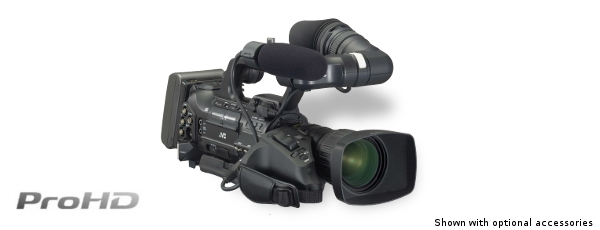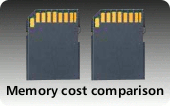| Performance
|
- Designed to Achieve Higher HD Picture Quality with JVC's Advanced Technologies
-
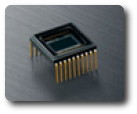 The GY-HM710 utilizes three precisely aligned 1/3-inch progressive scan full HD CCDs—one each for red, green and blue primary color—and outputs full resolution in both 1080 interlace and progressive. JVC's advanced ProHD capture technology incorporates a new patent-pending Adaptive Pixel Correlation Technique (APCT), and combined with TRIPLEX Offset Technology delivers exceptional resolving power comparable to cameras with larger image sensors.
The highly efficient ProHD form of H-V pixel shift, where the Blue pixels' sensor array is
shifted ½ pixel horizontally, while the Red pixels' sensor array is shifted ½ pixel vertically (both referenced to the Green array), enables recovery of additional luminance detail between the photosites of each pixel. By applying the Adaptive Pixel Correlation Technique, the camera achieves a remarkable improvement in image texture and resolving power in the 1080i/p modes. The TRIPLEX/APCT system differentiates between
"object directions" in high frequency areas of the image, to the extent vertical, horizontal, diagonal (left) or diagonal (right), and then applies pixel compensation for lost pixels in high frequency areas. Furthermore, using a global shutter, the design minimizes wobbling during quick pans and fixed pattern noise in low light conditions, contributing to a more stable image.
The GY-HM710 utilizes three precisely aligned 1/3-inch progressive scan full HD CCDs—one each for red, green and blue primary color—and outputs full resolution in both 1080 interlace and progressive. JVC's advanced ProHD capture technology incorporates a new patent-pending Adaptive Pixel Correlation Technique (APCT), and combined with TRIPLEX Offset Technology delivers exceptional resolving power comparable to cameras with larger image sensors.
The highly efficient ProHD form of H-V pixel shift, where the Blue pixels' sensor array is
shifted ½ pixel horizontally, while the Red pixels' sensor array is shifted ½ pixel vertically (both referenced to the Green array), enables recovery of additional luminance detail between the photosites of each pixel. By applying the Adaptive Pixel Correlation Technique, the camera achieves a remarkable improvement in image texture and resolving power in the 1080i/p modes. The TRIPLEX/APCT system differentiates between
"object directions" in high frequency areas of the image, to the extent vertical, horizontal, diagonal (left) or diagonal (right), and then applies pixel compensation for lost pixels in high frequency areas. Furthermore, using a global shutter, the design minimizes wobbling during quick pans and fixed pattern noise in low light conditions, contributing to a more stable image.
Upgraded 35Mbps MPEG2 Encoder-
Drawing on its long experience of developing dedicated encoders for the broadcasting industry,
 JVC has equipped the GY-HM710U with a powerful MPEG2 encoder capable of compressing full 1920 x 1080 HD
video at up to 35 Mbps. The result is the pristine picture quality that professional users demand, from a
surprisingly compact and lightweight shoulder-mount camcorder. MPEG2 long GOP is the most widely accepted broadcast standard compression supported by all popular editing systems and broadcast servers. In the HQ mode, the encoder operates with a variable bit rate average of 35Mbps. The SP mode records at a constant bit rate of 25Mbps to ensure compatibility with a wide range of equipment.
JVC has equipped the GY-HM710U with a powerful MPEG2 encoder capable of compressing full 1920 x 1080 HD
video at up to 35 Mbps. The result is the pristine picture quality that professional users demand, from a
surprisingly compact and lightweight shoulder-mount camcorder. MPEG2 long GOP is the most widely accepted broadcast standard compression supported by all popular editing systems and broadcast servers. In the HQ mode, the encoder operates with a variable bit rate average of 35Mbps. The SP mode records at a constant bit rate of 25Mbps to ensure compatibility with a wide range of equipment.
The GY-HM710 supports major signal formats including 1920 x 1080, 1440 x 1080, and 720 x 480.
35Mbps 25Mbps 1920 x 1080/59.94i 1440 x 1080/59.94i 1920 x 1080/29.97p 720 x 480/59.94i 1920 x 1080/23.98p 1440 x 1080/59.94i (.mov only)
Standard Definition Recording Capability-
 Responding to the needs of the industry, the GY-HM710U, in addition to its capability as an HD recorder, offers Standard Definition recording for maximum flexibility. Recording in SD provides a time-saving alternative to down-conversion of HD material for SD broadcasts, which is still an industry standard in many countries worldwide. This feature offers a fundamental advantage for professionals with time-sensitive SD workflows.
Responding to the needs of the industry, the GY-HM710U, in addition to its capability as an HD recorder, offers Standard Definition recording for maximum flexibility. Recording in SD provides a time-saving alternative to down-conversion of HD material for SD broadcasts, which is still an industry standard in many countries worldwide. This feature offers a fundamental advantage for professionals with time-sensitive SD workflows.
High performance Canon HD lens-
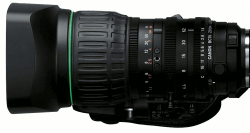 The GY-HM710U includes a detachable 14x Canon KT14x4.4KRSJ HD lens based on the superb optics found in more expensive HD lenses. Its superior MTF provides higher resolution than typical "stock" lenses. The lens has improved lateral and longitudinal chromatic aberration characteristics and is ideal for full 1920 x 1080 imaging. Canon's internal focusing system minimizes "breathing" compared with typical focusing systems. Internal focus also makes possible a more efficient light blocking lens hood. ENG shooters will be pleased with its wider angle and consistent brightness from 4.4mm (wide) to 62mm (telephoto) with no F-drop. Operation is the same as with all professional lenses, with mechanical control of focus, and servo or manual control of zoom and aperture.
The GY-HM710U includes a detachable 14x Canon KT14x4.4KRSJ HD lens based on the superb optics found in more expensive HD lenses. Its superior MTF provides higher resolution than typical "stock" lenses. The lens has improved lateral and longitudinal chromatic aberration characteristics and is ideal for full 1920 x 1080 imaging. Canon's internal focusing system minimizes "breathing" compared with typical focusing systems. Internal focus also makes possible a more efficient light blocking lens hood. ENG shooters will be pleased with its wider angle and consistent brightness from 4.4mm (wide) to 62mm (telephoto) with no F-drop. Operation is the same as with all professional lenses, with mechanical control of focus, and servo or manual control of zoom and aperture.
In addition to the GY-HM710's standard detachable 14x Canon lens, numerous lens options are available from JVC including the 13xTh13x3.5BRMU wide angle Fujinon zoom lens, a new 17x XT17sx45BRMK1 Fujinon zoom lens, 18x HTs18X4.2BRM Fujinon zoom lens, 20x KT20X5BKRS Canon zoom lens, and adapters that allow ½-in and 2/3" bayonet mount lenses to be used. Add the HZ-CA13U film lens mount adapter to the 1/3" bayonet mount, to enable mounting of 16mm film camera lenses to the GY-HM710, greatly expanding production lens options. The camera features an "image flip" function that corrects for the inverted image produced by prime lenses.
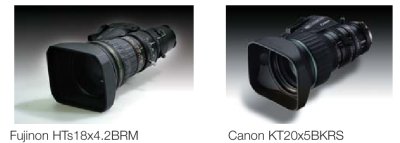
Secure Digital High Capacity (SDHC) memory card recording-
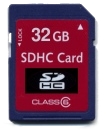 The GY-HM710 records on widely available SDHC Class 6 or Class 10 memory cards, presently available in capacities up to 32GB. The camera provides 2 memory card slots, for a total of up to 64GB of on board storage—enough for hours of continuous HD recording. In the relay mode, the camera automatically begins recording on the second card when the first card fills up. When the second card fills up, the camera will revert to recording to the first card slot, allowing for virtually unlimited recording lengths.
The GY-HM710 records on widely available SDHC Class 6 or Class 10 memory cards, presently available in capacities up to 32GB. The camera provides 2 memory card slots, for a total of up to 64GB of on board storage—enough for hours of continuous HD recording. In the relay mode, the camera automatically begins recording on the second card when the first card fills up. When the second card fills up, the camera will revert to recording to the first card slot, allowing for virtually unlimited recording lengths. 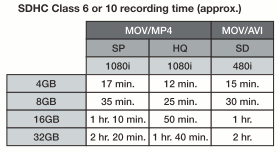
Class 6 or Class 10 cards are required. If a class 2 or 4 card is inserted, a warning indicator will be displayed. Being able to quickly switch cards with dual slots is invaluable in a breaking news situation where a producer may wish to begin editing while the shooter is still capturing footage.
Separate flip open covers protect card slots from dust, moisture and open separately for each card. If a cover is opened while the card is being recorded on, a warning message is displayed on the VF/LCD.
SDHC cards are economical, highly reliable, and make possible a recording system that consumes up to 20% less power than tape or HDD based systems. The per-minute cost of SDHC memory is comparable to professional video tape. Moreover, SDHC media is the first practical solid state solution to physical archive.
Native File Recording-
The GY-HM710 incorporates JVC's Native File Recording technology that stores video in the ready-to-edit file formats used by Apple's Final Cut Pro™, Adobe Premiere™, and other popular non-linear editing systems. The HD and SD ".mov" files created in the camera can be easily dragged onto Final Cut Pro's or Premiere's timeline or clip bin without conversion or rewrapping, saving time while keeping the recorded material first generation. There is no need to use an intermediate codec.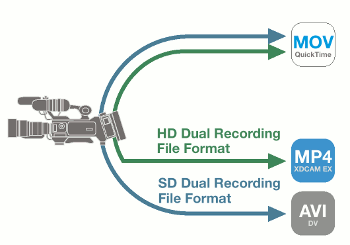
For users of other NLE systems, including solutions from Avid, Canopus and Vegas, the GY-HM710U supports the MP4 file format which can edited without re-encoding. HDV-compatible M2T files can also be created from these MP4 files using the ProHD Clip Manager. 4:2:2 uncompressed digital video is provided via HD-SDI output for recording onto an external recorder.
For standard definition applications, in addition to .mov format files, the GY-HM710 creates popular type-2 AVI files that imports easily into most current and legacy NLE systems.
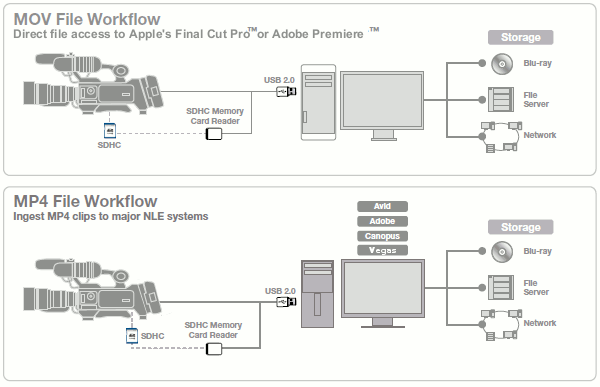
*1 Play back compatibility not guaranteed on different types of products due to variation of supported recording mode.
*2 MP4 is the compliant file format used on the XDCAM EX™
Pre Rec (Retro Cache) Start Mode—No more missed shots!- In this mode, the GY-HM710 continually records up to 20 seconds in cache memory. When the trigger is pressed, the live signal is appended to the cache recording, giving the shooter a head start in getting the shot. This feature is invaluable in capturing breaking events when the shot would be lost before a traditional camera could begin recording. When Pre Rec is activated, a "P" will be displayed in the viewfinder and on the LCD monitor.
Continuous Clip Mode- In this mode, the GY-HM710 creates a single clip file from multiple trigger presses. This is ideal when "in camera editing" is preferred. The complete shot sequence is instantly available as a single clip. When recording in the Continuous Clip Mode, time code can be either free run or in the REC mode.
JVC ProHD Clip Manager-
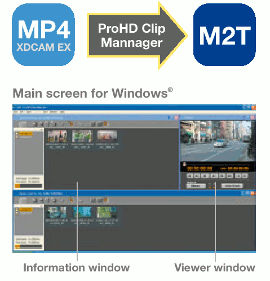 The ProHD Clip Manager for both Mac and Windows makes it easy
to manage MP4 clips on the GY-HM710U's memory cards from your
computer. With a few clicks of the mouse you can copy, move or
delete clips, preview clip content, as well as view and edit clip
metadata. A thumbnail view of all the clips in the current folder
shows the content of each clip at a glance. Use the viewer to watch
the whole clip, or change the clip's index frame used for the
thumbnail. You can also manage folders to keep your clips
organized, and check the remaining free space on a card. The latest
version of ProHD Clip Manager offers an even greater level of NLE
compatibility by enabling MP4 files to be converted to m2t widely
supported by NLEs.
The ProHD Clip Manager for both Mac and Windows makes it easy
to manage MP4 clips on the GY-HM710U's memory cards from your
computer. With a few clicks of the mouse you can copy, move or
delete clips, preview clip content, as well as view and edit clip
metadata. A thumbnail view of all the clips in the current folder
shows the content of each clip at a glance. Use the viewer to watch
the whole clip, or change the clip's index frame used for the
thumbnail. You can also manage folders to keep your clips
organized, and check the remaining free space on a card. The latest
version of ProHD Clip Manager offers an even greater level of NLE
compatibility by enabling MP4 files to be converted to m2t widely
supported by NLEs.
ProHD Log and Transfer Plug-in-
The ProHD Log and Transfer Plug-in is a software for Apple's Final
Cut Pro™ that lets you drop MP4 files recorded on the GY-HM710U
into the clip bin of Final Cut Pro™.
With the plug-in installed, you can view thumbnails of the MP4
files on a memory card from the Log and Transfer screen of Final Cut
Pro™. Simply drag and drop the thumbnails into the bin to
automatically convert the clips to QuickTime™, ready for use.
Unsurpassed Versatility
Compact Shoulder Form Factor- Weighing only 8.2 lbs including lens, viewfinder, microphone and battery, the GY-HM710 rests comfortably on the right shoulder providing stable, steady shots. Unlike some oversized hand held models, the GY-HM710 becomes part of the shooter similar larger cameras but without the fatigue associated with them. The handle has been redesigned for better carrying balance, and to accommodate wearing gloves in cold weather.
Configurable as an Affordable Studio Camera-
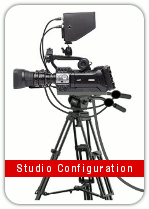 The GY-HM710 may be used as an inexpensive studio camera. JVC offers a variety of accessories such as a large monitor/viewfinder (DT-X71H and DT-X71F), rear lens controls, and a multi-camera switcher (KM-H3000.) The RM-LP55 remote control provides for adjustment of paint, white balance, gamma, shutter and lens iris. Connection to the switcher is made using a single HD-SDI cable looped through the external camera-mounted monitor.
The GY-HM710 may be used as an inexpensive studio camera. JVC offers a variety of accessories such as a large monitor/viewfinder (DT-X71H and DT-X71F), rear lens controls, and a multi-camera switcher (KM-H3000.) The RM-LP55 remote control provides for adjustment of paint, white balance, gamma, shutter and lens iris. Connection to the switcher is made using a single HD-SDI cable looped through the external camera-mounted monitor.
High resolution LCOS viewfinder- The GY-HM710 is equipped with a new, rugged high resolution viewfinder based on a new .45-inch 1.22 million pixel Liquid Crystal on Silicon (LCOS) panel (852 x 480 x 3). This new all-digital viewfinder displays images with more than 5 times the resolution of typical color viewfinders. Its sturdy reinforced die-cast aluminum chassis and LED light source ensure years of trouble-free operation. A serial digital interface means there's no quality loss, even with razor sharp graphic overlays. The viewfinder's native aspect ratio is 16:9. Safe area indications are available for popular aspect ratios including 2.35:1. In the record mode, audio level indications, battery remaining "fuel gauge" (when using digital batteries) and estimated time remaining for each memory card are displayed in the viewfinder. The Zebra function now offers 2 patterns (selectable.)
Jumbo size 4.3-inch flip-out LCD panel-
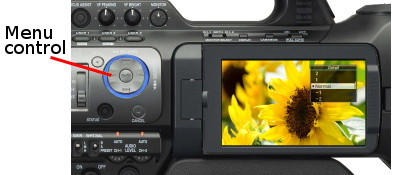
Complementing the new high resolution viewfinder is a large LCD flip out monitor that can be used in recording, playback, clip management, and menu operation. The 4.3-inch 800x480 WVGA LCD offers a 16:9 aspect ratio and provides a wide array of monitoring and setup indications. It is specially designed to reduce surface reflections and glare to maintain a clear, visible, bright view during outdoor recording. Menu items are easily selected using user-friendly setting cross keys.
Cross-key control makes menu navigation a breeze. The interface is very intuitive, with up down/left-right buttons on the same control disk. Selections are made by pressing the center of the disk. When in the camera mode, a blue LED lamp outlines the disk. When in the media playback/management mode, the color changes to green. A Red display indicates that the camera is in the USB or IEEE-1394 (slave) mode. (The LED can be turned off with a menu choice.)
Extensive image customization is available. Thanks to the oversize monitor screen, the user see changes to the image as the setting is being made, eliminating guesswork. Individual user settings are stored on an SDHC card and may be restored to any GY-HM710, GY-HM750, GY-HM790 or GY-HM700 camera.
Built-in Clip View & Management Functions-
When the camera is switched to the playback mode, a clip viewer appears on the large LCD monitor and in the VF. (This signal may also be output through the HD/SD SDI connector.) Clips are identified by time code and with a user defined filename with numeric increments.
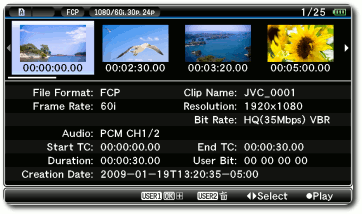
Detailed information is displayed about each clip including recording format, resolution, and time code start/stop, user bits, and creation date/time. Clips can be protected from accidental deletion or deleted if no longer needed. Damaged clips (due to improper eject, etc.) may be repaired with the "restore file" function. Though no special formatting is required, memory cards can be re-initialized in the GY-HM710 to an empty state even while the other card is recording.
The Quick Review function is available in the record-pause mode and allows the videographer to play back the first 5 seconds or the last 5 seconds of each clip, or the entire clip. After playback, the last image is retained (freeze) until the menu is reactivated. If during Quick Review, the record trigger is pressed, playback stops and recording begins immediately.
Spot Exposure Meter- When shooting very high contrast scenes, the Spot Meter can be a very useful tool, letting the videographer monitor the dynamic range of an image on the LCD/VF and adjust the exposure of an object in the frame. There are 4 modes of spot metering: Max/Min, Max, Min, and Manual. In the Max/Min mode, the highest and lowest levels of the image are identified with color markers, red (H) and white (L), along with the video level (before knee & gamma). The same values can be obtained individually with the Max and Min settings. Manual lets the videographer set the portion of the image to monitor. For example, in a scene with varied illumination, the videographer may wish to meter an individual's face, and set the exposure accordingly. As the scene changes, the exposure can be corrected precisely to the desired subject.
Uncompressed Audio Recording with Full Manual Control-
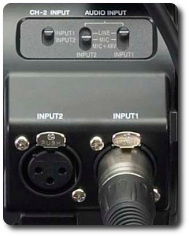 The GY-HM710U captures audio with the same uncompromising quality as video. Two-channel
16-bit/48 kHz uncompressed linear PCM (linear pulse code modulated) audio channels are recorded via the detachable shotgun microphone, or via a pair of balanced XLR connectors. Versatile input switching and independent channel assignment allow both mic and line-level sources (such as wireless receivers) to be connected, and phantom power is available on each XLR connector independently. Audio recording levels are controlled automatically or manually, with an audio level meter in the viewfinder and LCD monitor for easy monitoring.
The GY-HM710U captures audio with the same uncompromising quality as video. Two-channel
16-bit/48 kHz uncompressed linear PCM (linear pulse code modulated) audio channels are recorded via the detachable shotgun microphone, or via a pair of balanced XLR connectors. Versatile input switching and independent channel assignment allow both mic and line-level sources (such as wireless receivers) to be connected, and phantom power is available on each XLR connector independently. Audio recording levels are controlled automatically or manually, with an audio level meter in the viewfinder and LCD monitor for easy monitoring.

Patented "FOCUS ASSIST" function-
 Achieving exact focus with HD signals is critical. JVC's Focus Assist turns focusing into a fast, easy and accurate process. When Focus Assist is activated, the picture in the viewfinder becomes monochrome and all objects which are in focus take on a colored edge. Focus Assist works equally in the viewfinder as well as on the LCD panel. The Focus Assist function can be invoked by pressing the dedicated button on the control panel, or assigned to the RETURN button on the lens.
Achieving exact focus with HD signals is critical. JVC's Focus Assist turns focusing into a fast, easy and accurate process. When Focus Assist is activated, the picture in the viewfinder becomes monochrome and all objects which are in focus take on a colored edge. Focus Assist works equally in the viewfinder as well as on the LCD panel. The Focus Assist function can be invoked by pressing the dedicated button on the control panel, or assigned to the RETURN button on the lens.
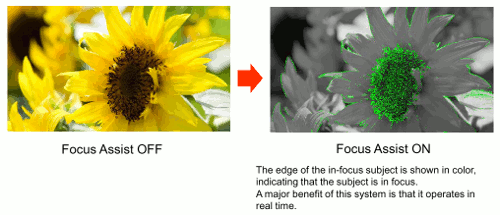
Connectivity
HD/SD SDI, IEEE1394 Output-
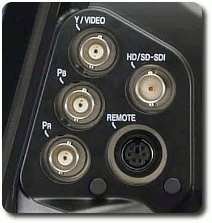 For live broadcast applications, or for monitoring, the GY-HM710 provides an uncompressed, 4:2:2 full HD or downconverted SD signal via its HD/SD SDI connector. The signal can come from either the camera or from memory playback. When 23.98p modes are selected, it will contain Varicam™ flags (1080p24 mode only) to facilitate post production. The HD/SD SDI output is via a BNC connector and includes embedded uncompressed audio. It is also possible to output the menus and clip viewer via the HD/SD SDI output.
For live broadcast applications, or for monitoring, the GY-HM710 provides an uncompressed, 4:2:2 full HD or downconverted SD signal via its HD/SD SDI connector. The signal can come from either the camera or from memory playback. When 23.98p modes are selected, it will contain Varicam™ flags (1080p24 mode only) to facilitate post production. The HD/SD SDI output is via a BNC connector and includes embedded uncompressed audio. It is also possible to output the menus and clip viewer via the HD/SD SDI output.
The IEEE1394 output is via a 4-pin connector and provides SD or HD depending on mode. The audio output is HDV compliant in HD mode and DV compliant in SD mode.
Component or Composite Video Output (selectable)- Component HD signals can be output via the BNC connectors on the camera. The signal will always be in the format being captured or played back. (Cross converting to another format is not possible.) Downconverted composite signals can be especially useful when providing an SD feed for a live webcast while simultaneously recording full HD. The composite output can also be provided when playing back recorded high definition material.
DV/HDV Output via IEEE-1394- DV signals are available through the 4-pin IEEE-1394 connector when the camera is recording or live in the SD (DV) mode, or when playing back an SD recording. These signals can be recorded on most "Firewire" recorders and will be in the NTSC mode. The IEEE-1394 connector also outputs an HDV compatible transport stream when the camera is live or recording in the SP (25Mbps) mode. No signal is available when playing back an HD recording.
VF-HP790 LCD Studio Viewfinder-
 The VF-HP790 is an 8.4-inch XGA (1024x768 pixels) LCD studio viewfinder designed to work with GY-HM790, GY-HM750, GY-HM710 or the GY-HM700. Designed to mount to the camera using the optional SA-K790 bracket, it is equipped with a large tally indicator, and screen hood. A fully digital interface provides all of the camera's viewfinder indications: safety markers, focus assist, power and clip management. The VF-HP790 is also provided with an HDSDI input for monitoring an external signal.
The VF-HP790 is an 8.4-inch XGA (1024x768 pixels) LCD studio viewfinder designed to work with GY-HM790, GY-HM750, GY-HM710 or the GY-HM700. Designed to mount to the camera using the optional SA-K790 bracket, it is equipped with a large tally indicator, and screen hood. A fully digital interface provides all of the camera's viewfinder indications: safety markers, focus assist, power and clip management. The VF-HP790 is also provided with an HDSDI input for monitoring an external signal.
Remote Camera Control Connector-
A 6-pin remote connector provides a TTL interface to an optional JVC RM-LP25U or RM-LP55U control unit. Extensive control options are available including shading, paint, iris, gamma level, knee, gain, shutter and black level. Functions vary with each unit.
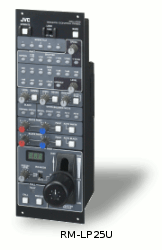
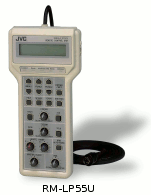
XDCAM EX™ is a trademark of Sony Corporation

